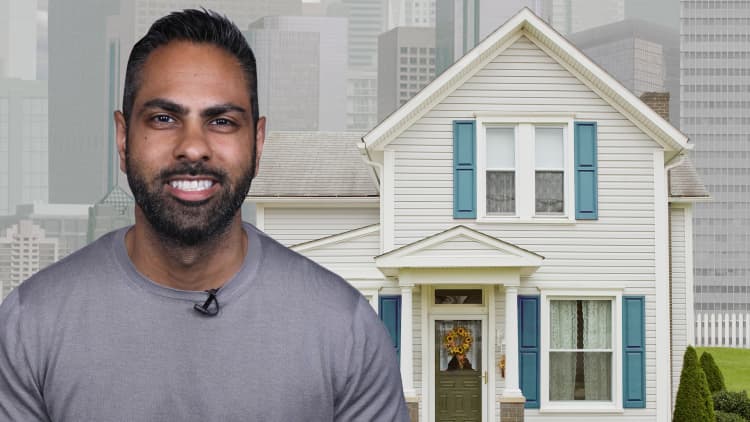Since 2011, rent prices in the U.S. have increased by 2% to 4% each year. As a result, city dwellers who earn minimum wage are finding it more difficult than ever to afford their rent.
That's according to a 2019 study from MagnifyMoney, which calculated the minimum wage of workers in 34 of the nation's largest cities, which had a population of 300,000 or more as of 2018, to determine the relative affordability of rental housing.
In order to rank these cities, MagnifyMoney analyzed data from the Joint Center of Housing Studies for median rent and the Economic Policy Institute. To find the estimated take-home pay after payroll tax, MagnifyMoney assumed 16% withholding in Social Security, Federal Insurance Contributions Act (FICA), Medicare and federal income tax.
Of the 34 cities ranked, 16 of them had median rent costs that exceeded 100% of a minimum-wage worker's monthly take-home pay. According to the study, those cities were:
16. San Francisco, California
Minimum wage: $15.59
Rent as a percentage of take-home pay: 101%
15. Denver, Colorado
Minimum wage: $11.10
Rent as a percentage of take-home pay: 103%
14. Baltimore, Maryland
Minimum wage: $10.10
Rent as a percentage of take-home pay: 103%
13. Indianapolis, Indiana
Minimum wage: $7.25
Rent as a percentage of take-home pay: 104%
12. Tampa, Florida
Minimum wage: $8.46
Rent as a percentage of take-home pay: 106%
11. Las Vegas, Nevada
Minimum wage: $8.25
Rent as a percentage of take-home pay: 111%
10. San Antonio, Texas
Minimum wage: $7.25
Rent as a percentage of take-home pay: 111%
9. San Diego, California
Minimum wage: $12
Rent as a percentage of take-home pay: 113%
8. Charlotte, North Carolina
Minimum wage: $7.25
Rent as a percentage of take-home pay: 114%
7. Orlando, Florida
Minimum wage: $8.46
Rent as a percentage of take-home pay: 116%
6. Houston, Texas
Minimum wage: $7.25
Rent as a percentage of take-home pay: 121%
5. Philadelphia, Pennsylvania
Minimum wage: $7.25
Rent as a percentage of take-home pay: 124%
4. Dallas, Texas
Minimum wage: $7.25
Rent as a percentage of take-home pay: 125%
3. Atlanta, Georgia
Minimum wage: $7.25
Rent as a percentage of take-home pay:129%
2. Miami, Florida
Minimum wage: $8.46
Rent as a percentage of take-home pay: 132%
1. Austin, Texas
Minimum wage: $7.25
Rent as a percentage of take-home pay: 143%

Of all of the cities ranked, Austin, Texas, is the least affordable city for low-wage earners. In fact, those making minimum wage salaries would need to work about 200 hours a month to be able to afford the median rent of $1,220, according to the report.
In 12 of the 16 cities where the minimum wage to median rent ratio is the highest, minimum wage is less than $10 per hour, according to the study. And, eight of these 16 cities don't offer more than federal minimum wage, which has been $7.25 per hour since 2009.
However, just because a certain city has a higher minimum wage rate doesn't mean rent will take up less of their take-home pay. In San Francisco, for example, which has one of the highest minimum wages in the country at $15.59 per hour, also has a very high median monthly rent of $1,860, the study shows.
On the other hand, Chicago, Minneapolis and New York City were the three more affordable cities out of the 34 ranked by MagnifyMoney, meaning they had the lowest minimum wage to median rent ratio.
Chicago, which was the No. 1 most affordable, has a minimum wage of $13 and its rent as a percentage of take-home pay was 69%. Still, minimum wage workers would need to work over 96 hours to make enough to pay the median rent of $1,050.

As of 2018, America has become known as a "renter nation," with more people renting rather than owning a home. The reasons for this shift toward renting are numerous.
For one, there's a heightened demand for rental properties, which has driven prices up, according to the Real Wealth Network, a real estate investing website. And along with a higher rental demand in general, there's also an increasing demand from millennials (ages 24 to 39) and baby boomers (ages 55 to 74) to rent.
Millennials aren't prioritizing homebuying like previous generations did. And as baby boomers are getting older, they are selling their homes and downsizing into more manageable rental properties, according to Real Wealth Network.
Finally, down payments on homes aren't getting any cheaper. These days, an ideal down payment on a home is around 25% of the purchase price, according to David Bach, bestselling author and co-founder of AE Wealth Management. When you consider that the median home price in 2019 was around $234,000, that means people are expected to put down around $58,500.
That's a lot of money for many people when you consider all their competing expenses. As a result, more people are deciding to rent, which only drives rental prices up even further.
Like this story? Subscribe to CNBC Make It on YouTube!
Don't miss: Here's how long it takes to save up for a home on a normal person's salary in 10 big US cities



